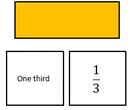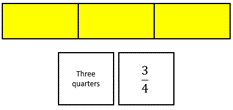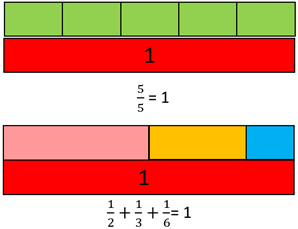The purpose of this activity is to support students understanding that non-unit fractions are counts of unit fractions. For example, 3/4 = 1/4 + 1/4 + 1/4, meaning three quarters is three counts of one quarter.
- Copymaster (laminated and cut into strips and cards)
- Refresh students’ familiarity with unit fractions by having them use the Copymaster to match the strip lengths to the unit fraction symbols and word cards. Highlight that the denominator and name of the fraction give clues about how many equal parts are needed. For example, one third, written 1/3, shows that three equal parts are needed. If appropriate to the needs of your learners, introduce te reo Māori kupu for fractions throughout the lesson (e.g. haurua - half, hautoru - third, hauwhā - quarter).
- Sort the strips and cards into sets of the same value. For example:

- Show students the card “three quarters.”
Can you find the number card for this fraction?
What do 3 and 4 tell you about how to make the fraction with strips?
Look for students to recognise that the numerator, 3, counts (numerates) how many equal parts they will need. You might model this using the strips.
Look for students to recognise that the denominator, 4, tells how big the parts should be. 4 means that four of those equal parts make one.
- Make 3/4 with the strips and put the word and symbol cards below it. Make sure to reinforce the meaning of the denominator by checking that the chose unit strip fits into one four times.

- Work through each of the non-unit fraction word cards. Find the matching number card and make the fraction with strips. Emphasise these points:
- Two halves, 2/2, is another name for one whole.
- Fractions with the same numerator are not equal unless their denominators are the same. For example, three quarters and three fifths are not the same length.
- Fractions that have a numerator that is one less than the denominator, need one more equal part to make one. For example, five sixths are one sixth smaller than one.
- Provide time for the students to work in pairs. One student writes a non-unit fraction in words and numbers. The other student makes that fraction with strips. Alternatively one student makes the fraction with strips and other students write the words and symbols. Pair up students to encourage tuakana-teina.
Next steps
- Find different ways to make one whole, 1, using the set of strips. Represent the ways using equations with fractions. Here are two examples:

Look for students to notice that a fraction equals one if the numerator and denominator are equal. They should also use non-unit fraction symbols in their equations. For example, 1/2 + 3/6 =1.